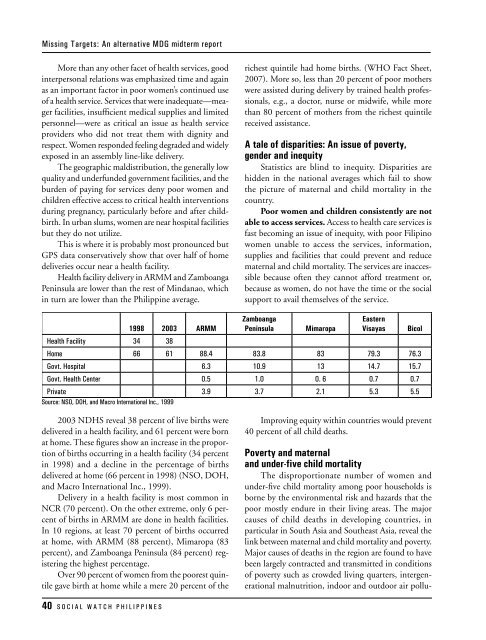one big file - Social Watch
one big file - Social Watch
one big file - Social Watch
You also want an ePaper? Increase the reach of your titles
YUMPU automatically turns print PDFs into web optimized ePapers that Google loves.
Missing Targets: An alternative MDG midterm report<br />
More than any other facet of health services, good<br />
interpersonal relations was emphasized time and again<br />
as an important factor in poor women’s continued use<br />
of a health service. Services that were inadequate—meager<br />
facilities, insufficient medical supplies and limited<br />
personnel—were as critical an issue as health service<br />
providers who did not treat them with dignity and<br />
respect. Women responded feeling degraded and widely<br />
exposed in an assembly line-like delivery.<br />
The geographic maldistribution, the generally low<br />
quality and underfunded government facilities, and the<br />
burden of paying for services deny poor women and<br />
children effective access to critical health interventions<br />
during pregnancy, particularly before and after childbirth.<br />
In urban slums, women are near hospital facilities<br />
but they do not utilize.<br />
This is where it is probably most pronounced but<br />
GPS data conservatively show that over half of home<br />
deliveries occur near a health facility.<br />
Health facility delivery in ARMM and Zamboanga<br />
Peninsula are lower than the rest of Mindanao, which<br />
in turn are lower than the Philippine average.<br />
richest quintile had home births. (WHO Fact Sheet,<br />
2007). More so, less than 20 percent of poor mothers<br />
were assisted during delivery by trained health professionals,<br />
e.g., a doctor, nurse or midwife, while more<br />
than 80 percent of mothers from the richest quintile<br />
received assistance.<br />
A tale of disparities: An issue of poverty,<br />
gender and inequity<br />
Statistics are blind to inequity. Disparities are<br />
hidden in the national averages which fail to show<br />
the picture of maternal and child mortality in the<br />
country.<br />
Poor women and children consistently are not<br />
able to access services. Access to health care services is<br />
fast becoming an issue of inequity, with poor Filipino<br />
women unable to access the services, information,<br />
supplies and facilities that could prevent and reduce<br />
maternal and child mortality. The services are inaccessible<br />
because often they cannot afford treatment or,<br />
because as women, do not have the time or the social<br />
support to avail themselves of the service.<br />
1998 2003 ARMM<br />
Health Facility 34 38<br />
Zamboanga<br />
Peninsula<br />
Mimaropa<br />
Eastern<br />
Visayas<br />
Home 66 61 88.4 83.8 83 79.3 76.3<br />
Govt. Hospital 6.3 10.9 13 14.7 15.7<br />
Govt. Health Center 0.5 1.0 0. 6 0.7 0.7<br />
Private 3.9 3.7 2.1 5.3 5.5<br />
Source: NSO, DOH, and Macro International Inc., 1999<br />
Bicol<br />
2003 NDHS reveal 38 percent of live births were<br />
delivered in a health facility, and 61 percent were born<br />
at home. These figures show an increase in the proportion<br />
of births occurring in a health facility (34 percent<br />
in 1998) and a decline in the percentage of births<br />
delivered at home (66 percent in 1998) (NSO, DOH,<br />
and Macro International Inc., 1999).<br />
Delivery in a health facility is most common in<br />
NCR (70 percent). On the other extreme, only 6 percent<br />
of births in ARMM are d<strong>one</strong> in health facilities.<br />
In 10 regions, at least 70 percent of births occurred<br />
at home, with ARMM (88 percent), Mimaropa (83<br />
percent), and Zamboanga Peninsula (84 percent) registering<br />
the highest percentage.<br />
Over 90 percent of women from the poorest quintile<br />
gave birth at home while a mere 20 percent of the<br />
Improving equity within countries would prevent<br />
40 percent of all child deaths.<br />
Poverty and maternal<br />
and under-five child mortality<br />
The disproportionate number of women and<br />
under-five child mortality among poor households is<br />
borne by the environmental risk and hazards that the<br />
poor mostly endure in their living areas. The major<br />
causes of child deaths in developing countries, in<br />
particular in South Asia and Southeast Asia, reveal the<br />
link between maternal and child mortality and poverty.<br />
Major causes of deaths in the region are found to have<br />
been largely contracted and transmitted in conditions<br />
of poverty such as crowded living quarters, intergenerational<br />
malnutrition, indoor and outdoor air pollu-<br />
40 S O C I A L W A T C H P H I L I P P I N E S

















